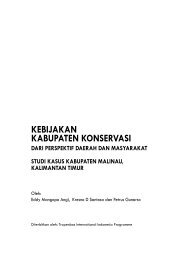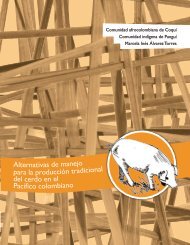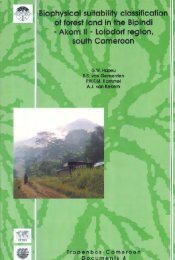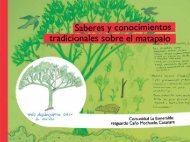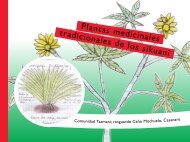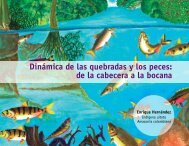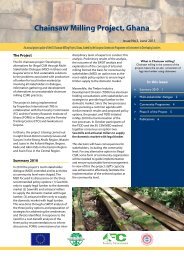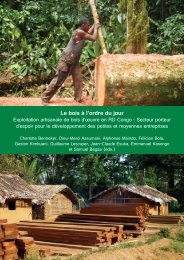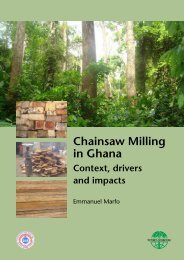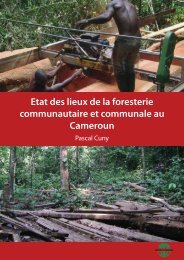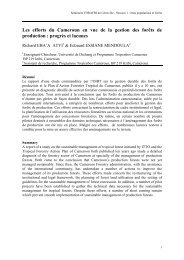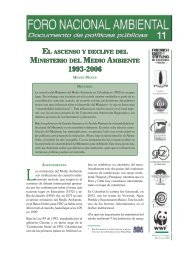Download the publication - Tropenbos International
Download the publication - Tropenbos International
Download the publication - Tropenbos International
Create successful ePaper yourself
Turn your PDF publications into a flip-book with our unique Google optimized e-Paper software.
Central African tropical rain forest structure and composition<br />
hedinii, Anthonotha macrophylla, Diospyros gracilescens, Ficus vogeliana,<br />
Gilbertiodendron demonstrans, G. dewevrei, Millettia griffoniana, Neolemornniera<br />
batesii, Spondianthus preussii, Synsepalum brevipes, Syzygium guineense var.<br />
littorale, Uapaca guineensis, U. heudelotii, U. staudtii, and Vitex doniana. Narrowleaved<br />
rheophytic shrubs such as Alsodeiopsis zenkeri, Ixora fastigata, Garcinia sp.,<br />
Ouratea dusenii, and Rinorea sp. nov. are commonly found along <strong>the</strong> Ntem and<br />
Bongola rivers.<br />
11. Mangroves<br />
There are many small creeks, sometime with small estuaries and wetlands in <strong>the</strong><br />
Campo-Ma’an area. Occasionally, <strong>the</strong>se habitats ei<strong>the</strong>r support a few clumps of tall<br />
mangroves dominated by tall Rhizophora racemosa and Pandanus candelabrum<br />
species or a population of short mangroves dominated by small Rhizophora<br />
racemosa and Pandanus satabiei. These mangrove trees (20-30 m tall) bear<br />
spectacular aerial roots forming a dense matrix on which one can cross <strong>the</strong><br />
mangrove one or two metres above <strong>the</strong> mud during dry seasons. More often short<br />
mangroves are fringed by seasonally flooded forests which are dominated by Crudia<br />
klainei, Guibourtia demeusei, Hallea stipulosa, Hibiscus tiliaceus, Lonchocarpus<br />
sericeus, Phoenix reclinata, Syzygium guineense var. littorale, Raphia and Uapaca<br />
species.<br />
12. Aucoumea klaineana forest (Okoumé 1&2)<br />
Although Okoumé communities do not form a vegetation type per se in <strong>the</strong> Campo-<br />
Ma’an area, it is worth mentioning its occurrence in Cameroon since Aucoumea<br />
klaineana is reaching its nor<strong>the</strong>rn limit of distribution in <strong>the</strong> area. It only occurs in<br />
small patches around Ebianemeyong on exposed steep hills or to <strong>the</strong> south of Ma’an<br />
close to <strong>the</strong> border with Equatorial Guinea around Nsengou and Ngo’ambang. In<br />
Ebianemeyong, <strong>the</strong> forest is opened and dominated by Aucoumea klaineana<br />
sometimes forming a distinctive near mono-dominant stands on exposed steep hills.<br />
In <strong>the</strong> Ma’an area, small clumps of Okoumé occur in open areas dominated by<br />
species of Haumania danckelmaniana and many rattans species. Despite <strong>the</strong><br />
apparent virgin nature of this forest type, it has a strong secondary character in terms<br />
of species composition.<br />
In addition to <strong>the</strong>se vegetation types, degraded coastal forest, lowland evergreen rain<br />
forest or mixed evergreen and semi-deciduous forests are mostly found along roads<br />
and logging paths, near settlements and industrial sites. Secondary forests are often<br />
dominated by pioneer trees species such as Albizia adianthifolia, Alchornea<br />
cordifolia, Anthocleista schweinfurthii, Bridelia micrantha, Cleistopholis patens,<br />
Dichaetan<strong>the</strong>ra africana, Harungana madagascariensis, Musanga cecropioides,<br />
Rauvolfia caffra, R. vomitoria, Trema orientalis, and Macaranga species.<br />
29



